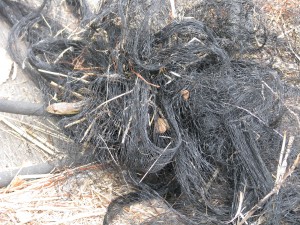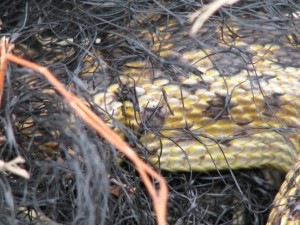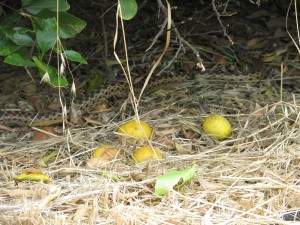Unsticking the Snake

This morning as I was wandering through my vegetable garden, I saw the middle part of a snake with his tail and head covered. This was late morning, and he wasn’t moving so I thought him dead. Fortunately he wasn’t. At first I thought he was a rattlesnake by the way his scales were rougher and the sound of a faint rattle when I moved the bamboo that lay under him.

He wasn’t; he was a three and a half foot gopher snake, the same one I’d seen about a month ago for the first time in my yard. Just about all snakes shake their tails when giving a warning, but rattlesnakes have stacked hollow sections of keratin… the same material that is in your fingernails and hair… that bump together when shaken to create that rattle sound. No, there aren’t any balls inside. Rattles appear with age but can come off, so a very young rattler with only one button or a snake that has his broken off won’t make a rattle but will still shake his (or her) tail. But I digress.
This gopher snake was in distress because it had crawled through plastic netting that I had carelessly left on the ground. Once about 25 years ago I had a similar situation when I lived in Vista, when a gopher snake became emmeshed in the holes of a plastic garden netting I’d set up. It took me a while to free it, and it wasn’t nearly as badly stuck as this poor guy.
This netting was the type used to cover fruit trees to protect them from bird predation, and I had some that I’d used briefly over my pea shoots when the crows were eating them. I’d left the netting in a nursery can but over the months it ended up on the ground with a snake stuck in it. I had to carefully cut the poor thing out.

About two inches of his head was showing once I pulled the netting back; not enough to swing around and bite me. He was stuck multiple times with the netting cutting into his skin in several places. I brought back a kitchen knife with a flat top and a sharp edge to it, so that I wouldn’t hurt him when I pressed down to slide the edge under the netting, but the tip of the knife wasn’t sharp enough. I ended up with some very sharp sewing scissors… the miniature kind shaped like a swan. And, of course, my camera.
The dilemma was that if I freed up enough of it’s middle it would try to push forward and become even more tightly stuck in the netting higher up. If I freed more of its top part first then it would have the leverage to turn and bite me.
When dealing with frightened animals (and people) you have to find the quiet part of yourself and work from there, without distraction and using a calm voice. Not only are your actions imperfect when you are tense or scared or angry, but that feeling emanates out from you and whatever you are working on will react to it. In other words, sensing your fear is a very real thing. I was very glad that this wasn’t a rattlesnake. The snake shook it’s tail at me several times and kept flicking it’s tongue out to smell me, but even though he wasn’t badly hurt or sick yet he was a very nice snake. I pulled the netting away from his head so that his trajectory when freed wouldn’t send him into more of the plastic loops.

Then I started sliding the scissors as gently as I could under the plastic netting that was pressed into his soft skin and cutting him free. He was badly stuck so it took some time.

All the while I spoke calmly to him, and knew that he would only feel relief after each of my actions so he’d know I wasn’t doing him harm. Finally I got to the netting around his… um… neck? He turned his little head but wasn’t rattling or coiling in preparation to move suddenly.

With the last snip he raced away several feet to the shade under a nearby lime tree.

There he sat looking back at me. I waved and told him he was welcome to all the gophers he could eat, and threw away the netting.
The lesson here, of course, is to be careful with the debris you leave around your yard. Could it be an animal trap? Think beyond it to the animals at the dump where your trash ends up. Snipping your 6-pack plastic rings might save the lives of seagulls, water creatures (if it ends up somehow in the water), or rodents. Of course, going plastic-less would be the ideal but still wouldn’t eliminate injury to animals. Tin cans are stuck on animals’ heads all the time. Just be aware of what you have lying around and consider if it could be a hazard or not. That way it might save you from snipping plastic rings off a snake someday.

2 Comments
DIANE
I think sticky traps are inhumane, and dangerous for non-targeted animals. We used to use them years ago for a rat problem, and we caught lizards instead. In fact, the use of sticky traps pushed me over the edge into vegetarianism because I just couldn’t see how we could be feeding a pet mouse in a clean cage with an exercise wheel up in the house, and below the house have sticky traps set for wild mice to die horrible slow painful deaths on. The hypocrasy was too much for me to bear, and I decided that compassionate eating and pest control had to be the way to go for me. I don’t remember what we used to get the lizards off the traps… thanks for the mineral oil tip!
Toni
I had the satisfaction of freeing a king snake from a “sticky” trap once. Mineral oil is the trick there.